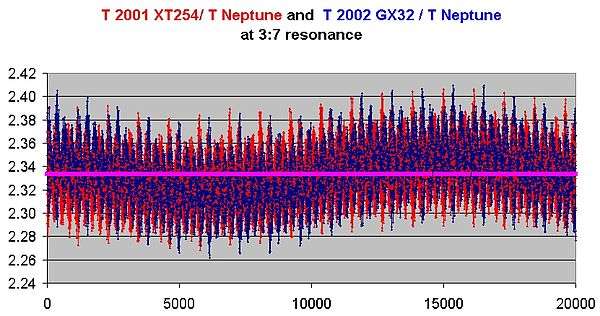(95625) 2002 GX32
| Discovery[1] | |
|---|---|
| Discovered by | M. W. Buie, A. B. Jordan, J. L. Elliot |
| Discovery date | 8 April 2002 |
| Designations | |
| MPC designation | (95625) 2002 GX32 |
|
SDO[2] 3:7 resonance[3][4][5] | |
| Orbital characteristics[1] | |
| Epoch 13 January 2016 (JD 2457400.5) | |
| Uncertainty parameter 3 | |
| Observation arc | 1478 days (4.05 yr) |
| Aphelion | 73.624 AU (11.0140 Tm) |
| Perihelion | 33.082 AU (4.9490 Tm) |
| 53.353 AU (7.9815 Tm) | |
| Eccentricity | 0.37994 |
| 389.71 yr (142343 d) | |
Average orbital speed | 3.91 km/s |
| 17.588° | |
| 0° 0m 9.105s / day | |
| Inclination | 13.922° |
| 28.097° | |
| 185.83° | |
| Earth MOID | 32.0761 AU (4.79852 Tm) |
| Jupiter MOID | 27.6446 AU (4.13557 Tm) |
| Physical characteristics | |
| Dimensions | 153 km (assumed)[6] |
| 0.09 (assumed) | |
| Temperature | ~38 K |
| 7.4[1] | |
|
| |
(95625) 2002 GX32, also written as (95625) 2002 GX32, is a trans-Neptunian object that resides in the Kuiper belt.[2] It has a 3:7 resonance with Neptune.[3] It was discovered on April 8, 2002 by Marc W. Buie, Amy B. Jordan, and James L. Elliot.
It came to perihelion in 1997.[1]
Assuming a generic TNO albedo of 0.09, it is about 153 km in diameter.[6]
Resonance
Simulations by Emel’yanenko and Kiseleva in 2007 show that (95625) 2002 GX32 has a 99% probability of librating in a 3:7 resonance with Neptune.[7]
The Neptune 3:7 mean-motion resonance keeps it more than 11 AU from Neptune over a 14000-year period.[4]
It has been observed 21 times over 4 oppositions and has an orbit quality code of 3.[1]

The orbital period of both 2002 GX32 and 2001 XT254 around the 3:7 (2.333) resonance of Neptune.
References
- 1 2 3 4 5 "JPL Small-Body Database Browser: 95625 (2002 GX32)" (2004-06-09 last obs). Retrieved 7 April 2016.
- 1 2 "List Of Centaurs and Scattered-Disk Objects". Minor Planet Center. Retrieved 2009-01-29.
- 1 2 Marc W. Buie. "Orbit Fit and Astrometric record for 95625" (2006-04-25 using 25 observations). SwRI (Space Science Department). Retrieved 2009-01-29.
- 1 2 "MPEC 2004-N31 : 2002 GX32 = 1994 JV". Minor Planet Center. 2004-07-12. Retrieved 2009-01-29.
- ↑ "MPEC 2009-A63 :Distant Minor Planets (2009 JAN. 29.0 TT)". Minor Planet Center. 2009-01-13. Retrieved 2009-01-30.
- 1 2 Wm. Robert Johnston (22 August 2008). "List of Known Trans-Neptunian Objects". Johnston's Archive. Retrieved 2009-01-29.
- ↑ Emel’yanenko, V. V (2008). "Resonant motion of trans-Neptunian objects in high-eccentricity orbits". Astronomy Letters. 34: 271–279. Bibcode:2008AstL...34..271E. doi:10.1134/S1063773708040075.
External links
- Orbital simulation from JPL (Java) / Horizons Ephemeris
- (95625) 2002 GX32 at the JPL Small-Body Database
This article is issued from Wikipedia - version of the 9/9/2016. The text is available under the Creative Commons Attribution/Share Alike but additional terms may apply for the media files.